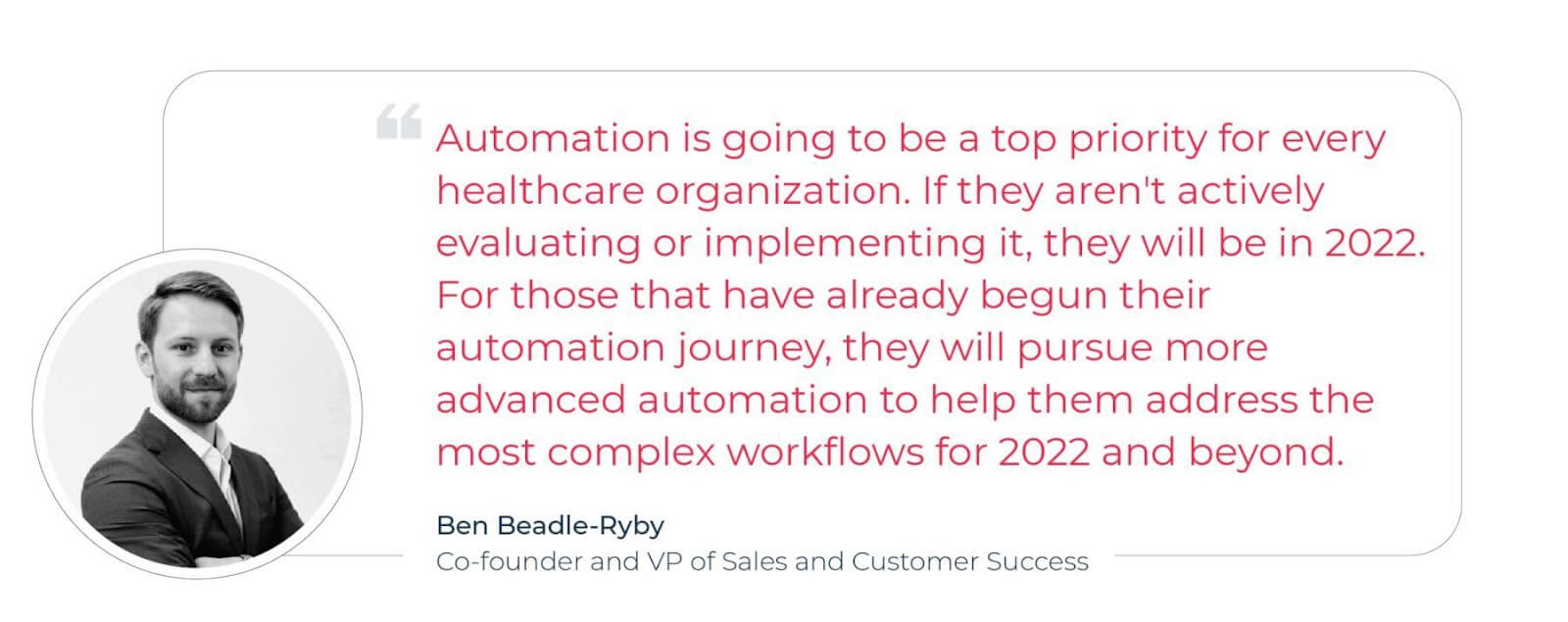The Gist
As the year comes to a close, it’s time to look ahead to the healthcare revenue cycle trends in 2022. What should healthcare leaders start planning for to be more efficient and effective? To help you prepare for 2022, some of AKASA’s revenue cycle, healthcare, and AI specialists weigh in on what the future will look like for the revenue cycle.
The healthcare industry is in a constant state of flux. Scientists discover and develop new vaccines every year, while technology continues to find inroads from the operating room to the back office.
Despite the advancements in healthcare, the back office revenue cycle is typically stagnant, with healthcare revenue cycle trends changing very little. Key performance indicators (KPI) haven’t changed in years, cost to collect hasn’t improved, confusion around RPA vs. AI is prevalent, and revenue departments continue to face the same staffing challenges they’ve faced for years.
At least, they did until COVID-19 hit.
COVID-19 has thrust most of the world into change, willing or not. Now, revenue departments are facing their usual staffing challenges, coupled with the Great Resignation. It’s no surprise that more than half of healthcare organizations say work and claim volumes are erratic, thanks to the pandemic.
With COVID-19 flipping the healthcare world on its head, an increasing demand for automation, and a dwindling workforce, 2022 is bound to be a year of flux for revenue cycle departments everywhere.
We don’t have a crystal ball, but we do have a team of experienced revenue cycle, healthcare, and AI specialists ready to weigh in with their predictions for the most significant healthcare revenue cycle trends of 2022.
Staffing Challenges Are Only Getting Worse
Staffing challenges in the revenue cycle space are nothing new. But, in the wake of the pandemic and the Great Resignation, could 2022 see essential changes coming to the staffing challenges in the revenue space?
Malinka Walaliyadde, CEO and Co-founder

Every healthcare leader we talk to knows that AI is the future and has an ambitious vision that they can’t execute due to legacy constraints. But challenging events have always been an accelerator for new technology and thinking to take hold. Now the old ways don’t work, and we have to do something different.
The complexity of healthcare has always made staffing a challenge, but the pandemic is now making adequate staffing an impossibility. Health systems simply can’t get the staff they need to get all the work done. So we have to change the way we work. We need to eliminate repetitive tasks and leverage our minimal staff to work on only the most cognitively complex activities.
Making these changes doesn’t just help us solve today’s staffing problems. It helps us as an industry transform and deliver a fundamentally better healthcare experience for the future. This pandemic is the crucible from which healthcare leaders can define their legacy and establish an AI foundation to set their health systems up for success for decades to come.
Christian Carlson, Director of Sales

COVID-related staffing challenges will continue to be a problem as the “Great Resignation” continues. As these staffing challenges go on, healthcare organizations will continue to see automation as one of the best solutions to the problem. This will likely result in more automation vendors cropping up and increased scrutiny over which ones are the best.
Sean Lara, Head of Partnerships and Strategic Accounts

The last 18–24 months have had everyone in crisis mode, which necessarily creates a focus on the near term. As we turn the corner on COVID, it will be vital for us to shift from near-term crisis management to long-term investment and planning — especially where COVID has acted as an accelerant for changes that will likely be with us for the foreseeable future. Chief among these is the workforce shortage brought on by the Great Resignation/Retirement. Organizations will need to retool their operations to match the new reality, both from workforce management and technology perspectives.
Conor O’Brien, Director of Sales and New Products

You’re going to see a continued focus on staffing as a revenue cycle trend in 2022. Revenue departments and health organizations will face the difficult challenge of balancing ‘labor arbitrage’ (reducing full-time employees as efficiency rises) with retaining A-List employees during the Great Resignation.
Recruiting and organizational reputation are considerations here, too. Will your organization be regarded as a “destination employer” if you had layoffs last month? In short: the balancing act of staying profitable or in the green, while ensuring you have enough staff, will become more delicate and more critical in 2022.
Jessica Edwards, Associate Director of RCO

Like other industries, the healthcare revenue cycle is likely to continue to have issues with staff turnover. There are a lot of hospitals and health systems that rely on a few individuals to be SMEs on processes and system functionalities. In those situations, when one person leaves, there is a gap in knowledge if the organization doesn’t have sufficient documentation. When appropriate documentation isn’t in place, training new staff (or staff that are new to that task) can be inefficient and lead to issues down the road when there’s a need for expert team members. To avoid future inefficiencies and unforced errors, organizations must focus on cross-training, documenting systems and processes, and investing in automation.
The Revenue Cycle Will Become More Patient-Focused
One assured healthcare revenue cycle trend for 2022: an increased focus on patients. The No Surprises Act will ultimately help patients have a better billing experience but also requires revenue departments to be on their toes. With automation in the revenue space growing more capable by the day, much of the revenue cycle can be automated. Will this allow revenue specialists the opportunity to grow into patient advocates that ensure there are no nasty surprises in billing, or will workflows remain largely unchanged?
Catherine Afarian, Head of Corporate Communications

The revenue cycle serves as the unseen engine of healthcare. It’s the foundation for ensuring that patients get the full benefit of the coverage for which they are eligible and get a correct bill the first time — every time. Mitigating surprise medical bills and providing price transparency are all facilitated by the revenue cycle. Organizations that shift their thinking to view the revenue cycle as a patient advocacy organization (rather than a back-office function) will emerge as leaders in 2022.
Amy Raymond, Head of Revenue Cycle Operations

Staffing in the revenue space has always been difficult. Margins are thin, the work is tough, and burnout is very real. To combat the Great Resignation and the ongoing, decades’ old challenge of churn, we could see a shift in how revenue cycle specialists work.
Automation makes it possible to take a lot of the tedious work off the plates of revenue cycle specialists, freeing them up to become patient advocates. For instance, automating claims status frees them up to help with denials and deliver a better patient experience overall. The revenue cycle and its teams need to shift to being patient-first.
This shift in how revenue specialists work could help with engagement and increase buy-in into the overall mission of a healthcare system: to care for the community. This could have a tangible impact on churn in the revenue space, and I think revenue leaders would benefit significantly from using automation to take this approach.
Kelly Leo, Head of Product Marketing

If I look at where we’re going in revenue cycle management in 2022, the healthcare industry is undergoing a significant digital transformation that needs to enable the patient as a consumer of healthcare. Put the patient back at the center of their healthcare and health finances, just like they are with all other major aspects of their life.
Some additional trends I see are an increase in value-based reimbursements vs. FFS, an increase in telehealth and the implications from that, ongoing staffing issues, figuring out how to do more with less, figuring out a competitive advantage with price transparency and no surprise medical bills, deploying significant enhancements and less dependency on the EHR, exploring alternate revenue streams, and increasing usage of APIs that drive digital health and remote patient monitoring.
Many of these can all be looped back to the overarching theme of managing the “whole patient.” Having the complete picture of the patient — from care to finances, from in-person to virtual to remote to post-visit care coordination — needs to be a focus for the revenue cycle in 2022.
Jonathan Lamech, Director of RCO

A symbiotic relationship between all channels of the revenue cycle is essential in delivering a patient-centered healthcare delivery model. A patient-centric approach is vital in providing quality care.
We often only associate the words visit, encounter, or care with medical treatment. Insurance companies and providers need to be on the same team from point of service to payment. The rise in technology companies and the recent CMS mandate for price transparency have further solidified the path we’re on. This path will help patients understand their care and providers use technology to simplify processes and cut costs in RCM.
2022 will be a year of realizing that all healthcare (both healthcare systems and payers) are on the same team, and building trust is essential in providing patients with care. Having the technology to automate and simplify workflows in the RCM chain is vital to making this happen. Automating a process elevates the time taken to perform a task, giving time back to focus on other areas of care to the patient.
We’re moving in a fast-paced, technology-driven society, and healthcare technology is key to meeting the needs of providers, insurance companies, and patients.
Technology Will Continue Growing in Capability and Importance
COVID didn’t slow technological advancements down much. Automation is increasingly popular (usage by health systems jumped from 66% to 78% in less than a year, according to an AKASA survey), cloud-based computing is widely available, and it’s not uncommon for healthcare organizations to have tech stacks that rival those found in marketing. But, are all these technological bells and whistles style over substance or inevitable requirements in the revenue space?
Victoria Holl, Head of Performance Marketing

The complexity of the healthcare patient-provider-payer ecosystem creates tension for all constituents. In 2022, healthcare revenue cycle leaders will continue to seek out tools and technological solutions that can accelerate time to collections, while allowing revenue cycle teams to become patient advocates. Technology can handle the data-intensive tasks so that healthcare RCM teams can focus on complex claims and work with patients and their family members to navigate the shifting payer landscape.
Jessie Moses, Director of Customer Success

I think a major trend in the healthcare revenue cycle in 2022 will be an increased need for automation and streamlined workflows as we continue to see billing and claims follow-up workflows increase in complexity, while healthcare providers continue to struggle with resourcing constraints.
Hak Kim, AI Technology Lead

AKASA regularly presents and publishes research to make deep learning helpful in the revenue cycle. (Read our first two research publications about Autonomous Medical Coding and using Deep Learning for Payer Response Prediction.) I expect that processing more structured and semi-structured data together should make the AI models smarter to move providers from hospital to hospitality.
Joelle Newnam, Head of Sales

On the patient-experience front, I’m convinced that the demographics are shifting toward a more tech-savvy base. The next generation of hospital patients doesn’t want to spend time on the phone scheduling appointments or filling out insurance paperwork in triplicate. They will want ease and instant access to all that in an app. To the extent that automation in the revenue cycle can help eliminate some of that back and forth, it’s a worthwhile investment to try and drive future consumer loyalty.
David Khavari, Sr. Product Manager

In 2022, whether or not to automate the revenue cycle should no longer be a question. The technology is proven, and the economic benefits are real beyond the shadow of a doubt. The question should be how to automate more of the revenue cycle faster, with higher levels of reliability and resilience.
Andy Atwal, VP of Engineering and Co-founder

Healthcare needs to start thinking differently about security. Due to current regulations and outdated processes, security and IT teams in healthcare systems are often forced to handle things they shouldn’t have to, like running on-site data centers. It takes large teams and specific skill sets to run these operations. This has been one of the biggest blockers for healthcare technology innovation. They’re stuck in an old paradigm of everything having to be on-premises.
In the next year, I’d like to see healthcare organizations start to move into the cloud. When we built AKASA, we used an AWS cloud infrastructure and it allowed us to move fast and employ top security measures. AWS is an environment that has hundreds of thousands of engineers all focused on security. If health systems offloaded some of these operations, they’d be more efficient and safer in the end. And it would benefit all of their operations, including the revenue cycle.
Varun Ganapathi, CTO and Co-founder

The question on the minds of most businesses used to be, “Do we need automation?” Automation is increasing in popularity, so now the question is becoming, “How can we improve on automation? How can we actually leverage outliers to make our automation stronger, rather than failing when an outlier occurs?”
If you look up the self-driving car, a pioneering example of modern AI, you see stories around dangerous failures where human input would have made all the difference. The human-in-the-loop approach of including people in the AI process is going to be something you see more and more of in 2022 and beyond.
At AKASA and within the revenue cycle, this means having revenue specialists in the loop with your AI, ensuring the revenue process is not just automated, but successfully automated. If you want to automate all or part of the revenue process in 2022, you’re going to want AI that incorporates humans-in-the-loop. Otherwise, you’ll risk falling behind those that take this approach.
Peter Altenburg, Associate Director of Customer Success

What I think is happening and will continue to occur in 2022 is more investment in innovative, intelligent technologies.
You’ll see automation companies get better at what they do. There’s going to be more data and proof that it works. Companies have tried delivering automation in the past, but haven’t really been that successful. You’re left with providers and healthcare leaders who are hesitant to employ these vendors and technologies. “We gave this company a shot. Gave a bunch of money and time, and it’s just not really doing what we were expecting.”
As more advanced and sophisticated automation companies (like AKASA) get better, we’re going to see more results and have more data about how this technology can truly make the revenue cycle more efficient.
Ben Beadle-Ryby, Co-founder and VP of Sales and Customer Success

Automation is going to be a top priority for every healthcare organization. If they aren’t actively evaluating or implementing it, they will be in 2022. For those that have already begun their automation journey, they will pursue more advanced automation to help them address the most complex workflows for 2022 and beyond.
In the short term, health systems are facing workforce shortages, which they’ll have to address. This will necessitate a look at a more sustainable long-term strategy as well, and many organizations will recognize the importance that automation plays in their overall productivity equation.
Price transparency mandates and how they impact the patient financial experience will continue to be a crucial revenue cycle initiative. For years, many groups have talked about investing in the patient financial experience creating the digital front door for their patients. Where many of them have struggled is seeing the ROI in it and truly investing in what’s needed. With the no surprise medical bills and some of the rules and mandates that have been put in place or are on the immediate horizon, they’re going to be forced to tackle this.
There’s also going to be a renewed emphasis on denials, on creative approaches to reduce initial denials and write-offs, leveraging AI and machine learning that previously wasn’t there. Many groups have attempted analytics dashboards and workflow tools, but those aren’t cutting it as the volume of denials continues to rise. Future state with advanced AI: Predicting denials before claims are submitted and preventing them through automative corrective action.
Grant Messick, Head of Customer Success

We’re going to continue to see a lot of noise around automation. It’s a continuous topic of conversation throughout the industry. There are a lot of vendors entering the market. I think there will be a focus on how to ascertain who’s real and who’s not and how they can be helpful.
Ultimately, everything comes down to the fact that we still haven’t figured out how to drive high-quality care at a low cost. We’re continuing to figure out how to do that one way or another. Does that mean that health systems have to get bigger so that they can drive down their cost and get more efficient? Does that mean we need to turn to new technologies, new products? Does that mean that we need a new incentive program from the government?
We need better care at a lower cost. Everything driven in healthcare, not related to saving lives, will be centered around figuring that out.
Scott Hori, Associate Director of Sales

Healthcare revenue cycle modernization efforts in 2022 will need to go FAR to keep up with constantly evolving landscapes across labor shortages, regulatory changes, and aging/growing populations.
The revenue cycle of 2022 must be: faster, more adaptive, and resilient.
Stephanie Maestrone, Director of Enterprise Sales

Everyone is gravitating towards automation, but no one knows what it really means. What types of automation are available, and what they’re capable of. It’s so easy to think it’s all the same, but the results and impact vary greatly based on the technology behind it.
RPA, no matter how it’s masked, is a bot. Bots don’t learn. That’s why machine learning is cropping up across so many industries.
In 2022, I think ML-driven technology can help healthcare revenue cycle teams offset staffing concerns and better engage their staff. There’s too much busy work that goes into getting paid for providing patient care. Let people do the higher-yield/patient-facing tasks. Let technology do the rest.
Sanjay Siddhanti, Director of Engineering

The CURES Act currently limits the definition of Electronic Health Information to the elements in the USCDI, which are largely focused on clinical data. In October 2022, this definition expands to include all PHI that is stored electronically, which will include billing and claims data. Revenue cycle leaders should look to APIs that expose billing data as another data source to feed AKASA’s ML algorithms.
Automation Will Change the Focus for Revenue Cycle Teams
Automation will pave the way for a more efficient revenue cycle workforce that’s capable of doing more with less, possibly becoming patient advocates along the way. But what if automation itself is refocused within the revenue space to target different types of payers?
Beth Cable, Director of RCO

When I think of 2022, the first thing that comes to mind is changes to the structure of the billing office. Automation doesn’t have a reduction in staff, ever, so healthcare systems need to explore more stable staffing models.
With COVID, many billing offices were forced to go remote, proving that the job could be done remotely. There was a shift in telehealth following COVID; telehealth wasn’t as common pre-pandemic. Billing offices also likely saw an increase in denials, since there wasn’t as great a familiarity with the billing regulations — never mind the added complexity of COVID diagnosis and tests. This increase in denials could still be backlogged, requiring human staff. As a result of this, I think automation will gear toward how to comb through the COVID/telehealth-related denials since they are likely repeatable.
Wynne Campbell, Associate Director of Customer Success

Health systems may realize that their AR days are going to be higher. They’re going to have higher outstanding AR, but a more limited focused staff that’s able to affect the metrics that matter — the ones that actually impact net revenue.
Even if cash flow is a little slower, they’re getting more dollars in the door month-over-month with a smaller, more effective workforce.
Automation lends itself to this too, where automation is picking up those rote tasks that can easily be automated. Then you have more specialized folks that know how to pick up the phone and get Blue Cross to pay certain types of claims, and know how to handle unique claims out of international claims and that sort of thing we’d never have the volume to previously train on.
Setting Yourself Up for Revenue Cycle Success in 2022
No one knows exactly what 2022 has in store, but one thing’s certain: automation will play a part.
Revenue cycle operations have faced the same staffing challenges for decades, and those challenges have only increased in recent years. Efficiency is increasingly important, as hospitals face staffing shortages and patients experience delays in the billing cycle. With fewer hands available to do the work, you need to rethink how processes can be more effective.
AKASA unites automation with experts-in-the-loop that learn your revenue cycle inside and out, and teach the automation anything it needs to know along the way. With our AI-based automation solution, you can streamline numerous revenue cycle processes and give your staff the relief they need — in 2022 and beyond.
Sign up for a demo and see how AKASA can help your organization become more efficient and prepare for the healthcare revenue cycle trends to come.











